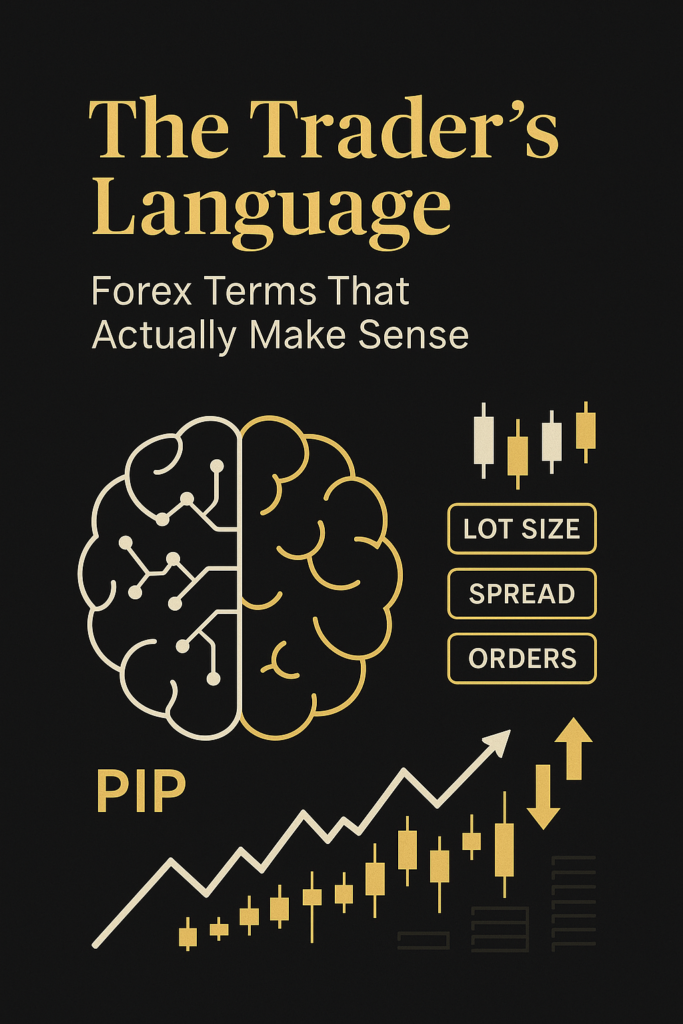
Honestly, the forex market is such an express. There is neither joining nor leaving one behind. The biggest sticking point for new traders and the new struggling intermediate is language. It makes this forex guide an eye-opener to forex terminologies. Clear relevant terms relevant to every serious trader without the jargon or textbook fluff.
This guide to aspiring traders, curious investors, and even semi-pros desiring a bit of brushing up. Whether you are just opening your first demo account or refining your live strategy, this is your go-to reference.
Core Forex Trading Terms
Currency Pairs Explained
In forex, you always trade one currency for another. That’s why you’ll see things like EUR/USD or GBP/JPY. These are currency pairs, and each pair tells a story about two economies competing in real-time.
| Pair Type | Example | What It Means |
| Major | EUR/USD | Includes the USD and another major currency |
| Minor | EUR/GBP | Excludes the USD but includes major FX pairs |
| Exotic | USD/SEK | One major + one emerging market currency |
Base vs. Quote Currency
Every pair has two sides. The base currency (first) is what you’re buying or selling. The quote currency (second) is what you’re using to measure its value. If EUR/USD = 1.10, you need 1.10 USD to buy 1 Euro.
Exchange Rate Basics
The exchange rate tells you how much of the quote currency you need to get one unit of the base currency. Rates shift constantly, influenced by economic news, central bank policies, and trader sentiment.
Bid and Ask Price
- Bid: What buyers are willing to pay
- Ask: What sellers want for the currency
You’ll sell at the bid and buy at the ask. The difference? That’s the spread.
Spread in Forex Trading
The spread is a built-in trading cost and varies based on currency pair, liquidity, and market volatility. Lower spreads are better for active traders.
Trading Mechanics and Tools
Leverage and Its Impact
Leverage is the reason forex is attractive—and risky. It lets you control larger positions with less capital. For example, 1:100 leverage means $100 can trade $10,000. Great for potential profits, dangerous if misused.
Margin and Margin Call
- Margin is the capital set aside to open a trade.
- Margin Call is your broker’s way of saying: “Add more funds or we’ll close your trades.”
Risky trades and high leverage can trigger a margin call fast.
| Term | Meaning |
| Used Margin | Capital locked into current positions |
| Free Margin | Funds available to open new trades |
| Margin Call | Broker request for more funds |
Lot Size and Types
Lots define trade size. The bigger the lot, the greater the risk—and potential reward.
- Standard Lot: 100,000 units
- Mini Lot: 10,000 units
- Micro Lot: 1,000 units
Choose the lot size that matches your account balance and risk appetite.
PIP – Small but Mighty
A PIP is the smallest price move in most currency pairs, typically 0.0001. It might sound tiny, but when trading large lots, a single pip can mean serious cash.
Slippage and Liquidity
- Slippage happens when your order is filled at a different price than expected—usually during volatile news or low liquidity.
- Liquidity refers to how easily a currency can be bought or sold. Higher liquidity = faster, more accurate execution.
Market Directions and Positions
Bullish vs. Bearish Trends
- Bullish Market: Prices are climbing, optimism reigns
- Bearish Market: Prices are falling, fear takes over
Knowing the trend helps you ride the wave instead of fighting the current.
Long and Short Positions
- Long Position: You buy, expecting the price to rise
- Short Position: You sell, hoping the price drops
Forex allows you to profit in both rising and falling markets. Flexibility is power.
Opening and Closing Trades
Opening a trade is just the start. Knowing when to close—whether to cut a loss or secure a profit—is what separates skilled traders from hopeful ones.
Order Types You Should Know
Market Order
Executes immediately at the best available price. Simple, fast, and perfect when speed matters more than price.
Limit Order
Executes only at a set price or better. It gives you control but no guarantees the market will reach your price.
Stop-Loss Order
Protects your capital by automatically closing a losing trade at a certain level. Non-negotiable for smart risk management.
Take-Profit Order
Locks in profits when your trade hits a pre-set target. Removes emotion from your exit strategy.
Stop-Entry Order
Used to enter the market when price breaks a certain level. Ideal for breakout strategies and momentum plays.
Analysis & Strategy Essentials
Technical vs. Fundamental Analysis
- Technical Analysis: Focuses on price patterns, indicators, and trends.
- Fundamental Analysis: Examines news, interest rates, and economic events.
Use both to get a fuller picture of market direction.
Support and Resistance Levels
- Support: Price floor—where buying interest kicks in
- Resistance: Price ceiling—where sellers push back
These levels act as psychological barriers and are crucial in timing entries and exits.
Volatility and Market Conditions
High volatility means big price moves—great for opportunity, dangerous for control. During volatile conditions, adapt your strategy and manage risk tighter.
Trading Psychology & Risk Management
Managing Emotions in Trading
Markets can test your nerves. Emotional control—staying calm during losses and disciplined during wins—is as important as any chart pattern or indicator.
Risk-Reward Ratio
A smart trade setup aims to risk less and gain more. A common target: 1:2 or higher (risking $100 to make $200). Consistency here keeps your edge.
Portfolio and Position Sizing
Don’t bet the house on a single trade. Position sizing ensures you’re not overexposed. Risk 1–2% of your capital per trade for sustainable growth.
Additional Forex Terminology
Carry Trade
You borrow in a currency with a low-interest rate and invest in one with a higher rate. The difference (the carry) can boost your returns—if the exchange rate moves in your favor.
Swap and Rollover
Swap is the interest you pay or earn for holding a trade overnight. It depends on the interest rates of the currencies in your pair and the direction of your trade.
Forex Broker and Execution
Your broker connects you to the market. Good brokers offer tight spreads, fast execution, and proper regulation. Bad ones… cost you money. Choose wisely.
Final Thoughts on Forex Terminologies
Understanding forex terms isn’t just about sounding smart—it’s about trading smarter. From spreads to slippage, leverage to lot size, this knowledge is the bedrock of every successful strategy.
Tips for Retaining Terms
- Create a personal forex glossary
- Use flashcards or quiz apps
- Apply terms in real (or demo) trading scenarios
- Teach someone else—it helps you master the language
Next Steps for Aspiring Traders
Now that the terminology makes sense, the next step is practice. Open a demo account, start watching the market, and test your understanding in real time. The more you trade, the more fluent you become.
